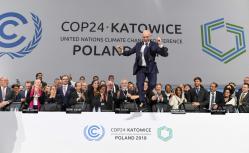![]() After 40 years of failure,
After 40 years of failure,
climate conferences must
change their strategy!
Le Figaro/Tribune by Francis Journot, published january 31, 2019 - The first Climate COP was organised by the UN in Geneva in 1979. This year also saw the completion of the Tokyo Round under the GATT (General Agreement on Tariffs and trade established in 1947). This decisive step in the first free trade treaty in history has led to an unprecedented acceleration in low-cost production and consumerism, but also in its perverse effects on the environment. We will not succeed in repairing this damage, but after the failure of the COP over the past 40 years, we must nevertheless try again to reconcile free trade, poverty reduction and environmental protection. ?
Defiance and green washing at COP 24
 In December 2018, COP 24 was expected to finalize the 2015 Paris agreements, but judging by the absence of most of the 138 heads of state and government who were awaited and a disappointing result, we can only observe mistrust towards the climate strategy. But do the Paris agreements still make sense when they are ignored by the world's leading power and trampled underfoot by the second, obsessed with maintaining high growth and above all eager for industrial opportunities such as electric batteries, solar panels and wind turbines, for which it now holds monopolies? The other countries are not virtuous either. Germany, the largest economy in the EU, like many other countries, continues to invest in the coal sector, which accounts for 44% of global greenhouse gas emissions. This industry took the opportunity to do its green washing and the conference was sponsored by the Polish JSW, Europe's leading coal producer. The textile industry also wanted to improve its image because it ranks second among the most polluting industries behind the oil industry and has contributed, since the advent of fast fashion, to hundreds of ecological disasters. Every year, it releases 500 000 tonnes of microfibres into the oceans and still uses working conditions close to slavery with monthly wages sometimes below $60 or $120. Represented by 43 fashion groups, it has signed a charter to reduce its GHG emissions by 2050. However, the number of clothes and accessories manufactured has doubled in 15 years to reach 100 billion items per year and 10% of CO2 emissions. These figures could double again over the next 20 or 30 years according to the UN Environment: "If nothing changes, by 2050 the fashion industry will use up a quarter of the world's carbon budget".
In December 2018, COP 24 was expected to finalize the 2015 Paris agreements, but judging by the absence of most of the 138 heads of state and government who were awaited and a disappointing result, we can only observe mistrust towards the climate strategy. But do the Paris agreements still make sense when they are ignored by the world's leading power and trampled underfoot by the second, obsessed with maintaining high growth and above all eager for industrial opportunities such as electric batteries, solar panels and wind turbines, for which it now holds monopolies? The other countries are not virtuous either. Germany, the largest economy in the EU, like many other countries, continues to invest in the coal sector, which accounts for 44% of global greenhouse gas emissions. This industry took the opportunity to do its green washing and the conference was sponsored by the Polish JSW, Europe's leading coal producer. The textile industry also wanted to improve its image because it ranks second among the most polluting industries behind the oil industry and has contributed, since the advent of fast fashion, to hundreds of ecological disasters. Every year, it releases 500 000 tonnes of microfibres into the oceans and still uses working conditions close to slavery with monthly wages sometimes below $60 or $120. Represented by 43 fashion groups, it has signed a charter to reduce its GHG emissions by 2050. However, the number of clothes and accessories manufactured has doubled in 15 years to reach 100 billion items per year and 10% of CO2 emissions. These figures could double again over the next 20 or 30 years according to the UN Environment: "If nothing changes, by 2050 the fashion industry will use up a quarter of the world's carbon budget".
Why climate COP cannot succeed
The high number of climate septic countries and the economic influence of many of them, make these world summits irremediably doomed to failure. The very title of the Climate Conference, which presupposes anthropogenic origin, and the content of the Paris Agreements, which focus on global warming, are counterproductive. They neglect the divisions and relegate the issue of other environmental problems which could more easily federate, to the background. The IPCC's alarmist report did not reduce the camp of scepticism and UN Secretary General Antonio Guterres had to extend the last COP by 28 hours to obtain some non-binding commitments.
The divide will not disappear at the next COP and perhaps it is also necessary to break with an ideological and manichean vision that encourages a "North-South" opposition. The industry developed mainly from the beginning of the 20th century, but the damage caused to the environment has been mainly over the last four or five decades.
Also, some States consider that in a context of permanent economic war exacerbated by the globalization promoted by the GATT (General Agreement on Tariffs and trade) and then the WTO, it is inconsistent to reproach them now for having followed this economic model which, 40 years ago, was also favoured by emerging or developing countries, even if some then benefited much more than others. At the end of the Tokyo Round in 1979, 102 signatory countries joined this choice of society that promoted growth and promised prosperity. The agreements then covered 300 billion dollars of trade instead of 40 billion in the previous round. Admittedly, everyone legitimately wanted development and poverty reduction for their country, but the risk of disastrous consequences, including the destruction of the environment, biodiversity and an increase in CO2 emissions, was already known. 60 other States joined them over the following decades. It is not surprising that the developed countries of the North, now judged by the Paris agreements, which are responsible for global warming and must therefore finance the energy transition of the countries of the South to the tune of 100 billion dollars per year from 2020, are not rushing to these global meetings or reluctant to write cheques, especially since a significant proportion of them do not feel responsible for the climate. It would be more consensual to rename the COP. A less ideological content that no longer confuses the various subjects, with new proposals and new insights into the less cleaved and concrete themes of demographic risk, environmental devastation and species extinction that no one can dispute, would make these conferences more credible and make it possible to combat GHG emissions more effectively.
Energy transition and electric cars: sustainable solutions or illusion?
It is regrettable that political parties and ecology NGOs have taken up the theme of global warming as their main focus and as a tool to influence domestic policies. This one now phagocytes the environmental debate. The Proposals that seem to be driven more by political ideology than by an interest in humanity often appear unrealistic. They are far from unanimous when they demand ever more energy taxes against consumers and businesses. The speech advocates the closure of fossil fuel power plants, but also in some countries of nuclear power plants that provide low-carbon electricity. But do we now have the necessary tools for a transition? Fossil fuels are polluting and nuclear waste difficult to store, but solar and wind energy can currently only provide complementary solutions in developed countries, given their intermittent nature.  However, the gradual adoption of this economic model, whose relevance has never been demonstrated, could lead to a significant increase in energy prices. It is also worth being cautious about the global ecological gain that could be achieved by apparently cleaner cars but whose electricity would in fact often come from coal, fuel oil or gas in neighboring countries or not. Emissions would decrease in metropolitan areas of countries with nuclear power plants, but pollution crosses borders. We can also fear the ecological risk of an anticipated replacement in a few years, of a large part of a fleet of nearly a billion cars in working order, with regard to the extraction of the necessary raw materials, the GHG emissions that would be generated by the production of billions of tons of materials, the management of car waste and new electric batteries that we do not yet know how to recycle and a ballet of container carriers that would also contribute to environmental pollution. The arrival on the market of tens of millions of additional cars per year, often subsequently exported (currently 4 to 5 million European vehicles are exported to Africa each year), would contribute to the suffocation of new cities.
However, the gradual adoption of this economic model, whose relevance has never been demonstrated, could lead to a significant increase in energy prices. It is also worth being cautious about the global ecological gain that could be achieved by apparently cleaner cars but whose electricity would in fact often come from coal, fuel oil or gas in neighboring countries or not. Emissions would decrease in metropolitan areas of countries with nuclear power plants, but pollution crosses borders. We can also fear the ecological risk of an anticipated replacement in a few years, of a large part of a fleet of nearly a billion cars in working order, with regard to the extraction of the necessary raw materials, the GHG emissions that would be generated by the production of billions of tons of materials, the management of car waste and new electric batteries that we do not yet know how to recycle and a ballet of container carriers that would also contribute to environmental pollution. The arrival on the market of tens of millions of additional cars per year, often subsequently exported (currently 4 to 5 million European vehicles are exported to Africa each year), would contribute to the suffocation of new cities.
When the pretext of ecology is used for taxation
 The carbon tax, which is based on the polluter pays principle (PPP) that appeared in 1972, is proving inefficient. International groups often manage to avoid it and, above all, it increases the burden on local businesses and consumers in 21 countries, 17 of which are located in Europe, without reducing consumerism. In France, the "yellow vests" revolt began following a planned annual increase of €3.7 billion in fuel taxes presented to finance the energy transition. But of the 37.7 billion euros that were to be collected in 2019 under TICPE (domestic consumption tax on energy products), 7.2 billion euros or only 19.1% was allocated to the transition. It is not surprising that motorists who are already struggling to pay for food and vital energy rise up when the government wants to force them into debt for electric cars or new boilers.
The carbon tax, which is based on the polluter pays principle (PPP) that appeared in 1972, is proving inefficient. International groups often manage to avoid it and, above all, it increases the burden on local businesses and consumers in 21 countries, 17 of which are located in Europe, without reducing consumerism. In France, the "yellow vests" revolt began following a planned annual increase of €3.7 billion in fuel taxes presented to finance the energy transition. But of the 37.7 billion euros that were to be collected in 2019 under TICPE (domestic consumption tax on energy products), 7.2 billion euros or only 19.1% was allocated to the transition. It is not surprising that motorists who are already struggling to pay for food and vital energy rise up when the government wants to force them into debt for electric cars or new boilers.
Economic shortages and upheavals
The environment pays a heavy price for every item produced and it is easy to imagine, given the demographics, that the resources of our planet will quickly run out. If we take a simple T-shirt, the carbon footprint is about 10 kilos from production to destruction, growing cotton can require 3,000 liters (792.5 gallons) of water and its journey can reach several tens of thousands of miles.  In the field of metals, "99.9% of theoretical resources will remain untapped" according to physicists Robert Underwood Ayres and Brian Skinner (MIT). The rapid decline in reserves over the past 50 years, the criticality or predicted scarcity in the coming years and decades of some 20 rare and precious metals now essential to the exponential production of the electronics industry, may give rise to fears of a future impact on a highly digitalized and increasingly automated global economy. The economist and mathematician Nicholas Georgescu-Roegen warned as early as 1979 "It is an illusion of linear thinking, modern mythology of progress and development to believe this abundance without ecological consequences and without limits." Shortages would upset our daily lives and could cause chaos much faster than global warming. States, populations and companies would suffer the effects of repeated financial crashes and conflicts would increase. We must save our reserves to delay this damage, but perhaps we will escape a future of science fiction, dehumanized and populated by machines.
In the field of metals, "99.9% of theoretical resources will remain untapped" according to physicists Robert Underwood Ayres and Brian Skinner (MIT). The rapid decline in reserves over the past 50 years, the criticality or predicted scarcity in the coming years and decades of some 20 rare and precious metals now essential to the exponential production of the electronics industry, may give rise to fears of a future impact on a highly digitalized and increasingly automated global economy. The economist and mathematician Nicholas Georgescu-Roegen warned as early as 1979 "It is an illusion of linear thinking, modern mythology of progress and development to believe this abundance without ecological consequences and without limits." Shortages would upset our daily lives and could cause chaos much faster than global warming. States, populations and companies would suffer the effects of repeated financial crashes and conflicts would increase. We must save our reserves to delay this damage, but perhaps we will escape a future of science fiction, dehumanized and populated by machines.
Create economic mechanisms to consume less but better
Nothing seems to be able to moderate over-consumption. Climate marches and petitions, which, although mediatized, only mobilize a tiny part of the population. They have no influence on a deregulated free trade model that favors low-cost production and an imposed offer to which consumers generally comply. The carbon tax is rejected by most countries. A reintroduction of tariff or non-tariff barriers is unlikely in the short term, considering the supply chains of products often made in the world and the possible sudden drops in growth that would destabilize the economies of many countries. As for the COP, they have failed for 40 years. So are we at a dead end? However, in order to reduce the damage,  it is imperative that we think of pragmatic economic solutions that are quickly operational and, above all, capable of bringing people together. In a globalized economy, the solutions are mainly global and downstream taxation has shown its limits. In order to reduce our consumption of disposable or obsolete products, we could use economic mechanisms upstream of production that could guide industrial companies towards a revaluation of their production. If we choose the example of fashion, when the labor cost is insignificant, the materials used are often of poor quality. These low-cost products, resold as low and mid-range but sometimes high-end, first offered with a high coefficient, are often then sold off or commonly destroyed. An increase in the wage cost could generate a new look, a valuation of products and a decline in the disposable.
it is imperative that we think of pragmatic economic solutions that are quickly operational and, above all, capable of bringing people together. In a globalized economy, the solutions are mainly global and downstream taxation has shown its limits. In order to reduce our consumption of disposable or obsolete products, we could use economic mechanisms upstream of production that could guide industrial companies towards a revaluation of their production. If we choose the example of fashion, when the labor cost is insignificant, the materials used are often of poor quality. These low-cost products, resold as low and mid-range but sometimes high-end, first offered with a high coefficient, are often then sold off or commonly destroyed. An increase in the wage cost could generate a new look, a valuation of products and a decline in the disposable.
Consequently, a global minimum wage offering 5 to 7 levels of compatibility with the economies of the countries concerned, initially sectorial, progressive and specific to production mainly intended for export to the USA and the EU, would generate an overall increase in the quality of articles and recreate balances without having a serious impact on the prices paid by Western consumers, if we consider also that it is not uncommon for an article to be sold 10 or 20 times its ex-works cost price and that unbridled competition in the consumer goods manufacturing industry would regulate prices. Given a rise in wages that would only concern a portion of the population and an increase in the value added of products that could offset a decrease in volumes, the nature and growth structure of producing countries would change more or less according to  the sectors of activity occupied, but states should not deplore sudden economic upheavals.The International Convention for a Global Minimum Wage project, launched in 2014, benefits from a global network of 2,000 economists who know the proposals. Among these are many researchers and professors who teach at American Ivy League universities (Harvard, Yale, Columbia, Cornell...) or Stanford, Berkeley, MIT and other prestigious schools but also economists working in international institutions such as the UN, WTO, World Bank, IMF, World Economic Forum or ILO. The global minimum wage could mark the beginning of a new and rich economic reflection if it is also ethical and philosophical. This could be a point of convergence between the WTO, which is engaged in a free trade policy but more aware than ever of its perverse effects at a time when calls for a paradigm shift are increasing, and the UN, which is seeking solutions that can slow the damage caused to the planet and reduce inequalities.
the sectors of activity occupied, but states should not deplore sudden economic upheavals.The International Convention for a Global Minimum Wage project, launched in 2014, benefits from a global network of 2,000 economists who know the proposals. Among these are many researchers and professors who teach at American Ivy League universities (Harvard, Yale, Columbia, Cornell...) or Stanford, Berkeley, MIT and other prestigious schools but also economists working in international institutions such as the UN, WTO, World Bank, IMF, World Economic Forum or ILO. The global minimum wage could mark the beginning of a new and rich economic reflection if it is also ethical and philosophical. This could be a point of convergence between the WTO, which is engaged in a free trade policy but more aware than ever of its perverse effects at a time when calls for a paradigm shift are increasing, and the UN, which is seeking solutions that can slow the damage caused to the planet and reduce inequalities.
Francis JOURNOT International Convention for a Global Minimum Wage
Copyright © 2013 - 2019 - non profit NGO International Convention for a Global Minimum Wage & Francis Journot Fair Consulting - All rights reserved
Make a free website with emyspot - Signaler un contenu illicite sur ce site
























